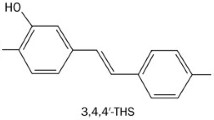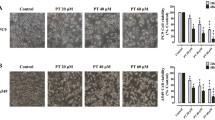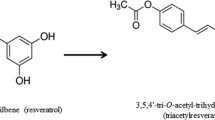Abstract
Lung adenocarcinoma is the most common subtype of non-small cell lung cancer and the leading cause of cancer death worldwide. In this study, we investigated the effect of resveratrol (Res) on lung adenocarcinoma A549 cells and its potential mechanism. We found after Res treatment, the interspace of A549 cells decreased and granular material increased in the cell nucleus. These changes were remarkably correlated with the increased concentration of Res. Res induces apoptosis in A549 cells and inhibits cell proliferation in a dose-dependent manner. We further showed that after Res treatment, expression of p53, Bax, and cleaved caspase-3 protein was dramatically up-regulated, while expression of Bcl-2 and the ratio of Bcl-2/Bax were down-regulated. Our study demonstrates that Res inhibits proliferation and induces apoptosis of A549 cells through regulation of p53, Bax, Bcl-2, and cleaved caspase-3 expression.




Similar content being viewed by others
References
Tiseo, M., Bartolotti, M., Gelsomino, F., & Ardizzoni, A. (2009). First-line treatment in advanced non-small-cell lung cancer: The emerging role of the histologic subtype. Expert Review of Anticancer Therapy, 9, 425–435. doi:10.1586/era.09.3.
Min, J. G., Zhou, Y. L., & Lv, G. R. (2013). Determination of resveratrol and 7,4′-dihydroxyflavone in Zhuang medicine Dracaema cochinchinensis bu HPLC. Chinese Journal of Information on TCM, 20, 61–63.
Movahed, A., Yu, L., Thandapilly, S. J., Louis, X. L., & Netticadan, T. (2012). Resveratrol protects adult cardiomyocytes against oxidative stress mediated cell injury. Archives of Biochemistry and Biophysics, 527, 74–80.
Pervaiz, S. (2003). Resveratrol: From grapevines to mammalian biology. FASEB Journal, 17, 1975–1985.
Valenzano, D. R., Terzibasi, E., Genade, T., Cattaneo, A., Domenici, L., & Cellerino, A. (2006). Resveratrol prolongs lifespan and retards the onset of age-related markers in a short-lived vertebrate. Current Biology, 16, 296–300.
Athar, M., Back, J. H., Kopelovich, L., et al. (2009). Multiple molecular targets of Resveratrol: Anti-carcinogenic mechanisms. Archives of Biochemistry and Biophysics, 486(2), 95–102.
Huang, N., Lu, H., Chang, L., Zhang, H., Zhang, H., & Li, G. (2010). [Resveratrol inhibits EGF-induced invasion of human lung adenocarcinoma A549 cells]. Zhongguo Fei Ai Za Zhi, 13(4), 287–291.
Liu, S., Li, Y., Qi, W., et al. (2014). Expression of Tiam1 predicts lymph node metastasis and poor survival of lung adenocarcinoma patients. Diagnosis Pathology, 9, 69. doi:10.1186/1746-1596-9-69.
Lee-Chang, C., Bodogai, M., Martin-Montalvo, A., et al. (2013). Inhibition of breast cancer metastasis by resveratrol-mediated inactivation of tumor-evoked regulatory B cells[J]. Journal of Immunology, 191(8), 4141–4151.
Sheth, S., Jajoo, S., Kaur, T., et al. (2012). Resveratrol reduces prostate cancer growth and metastasis by inhibiting the Akt/MicroRNA-21 pathway[J]. PLoS One, 7(12), e51655.
Ge, J., Liu, Y., Li, Q., et al. (2013). Resveratrol induces apoptosis and autophagy in T-cell acute lymphoblastic leukemia cells by inhibiting Akt/mTOR and activating p38-MAPK.[J]. Biomedical and Environmental Sciences, 26(11), 902–911.
Jang, M., Cai, L., Udeani, G. O., et al. (1997). Cancer chemopreventive activity of resveratrol, a natural product derived from grapes. Science, 275, 218–220.
Smith, N. D., Rubenstein, J. N., Eggener, S. E., et al. (2003). The p53 tumor suppressor gene and nuclear protein: Basic science review and relevance in the management of bladder cancer[J]. Journal of Urology, 169(4), 1219–1228.
Delia, D., Fontanella, E., Ferrario, C., et al. (2003). DNA damage-induced cell cycle phase regulation of p53 and p21waf1 in normal and ATM-defective cells[J]. Oncogene, 22(49), 7866–7869.
Renton, A., Llanos, S., & Lu, X. (2003). Hypoxia induces p53 through a pathway distinct from most DNA-damaging and stress-inducing agents[J]. Carcinogenesis, 24(7), 1177–1182.
Harvey, N. L., & Kumar, S. (1998). The role of caspase in apoptosis[J]. Advances in Biochemical Engineering/Biotechnology, 62, 107–128.
Ray, R. M., Bhattacharya, S., & Johnson, L. R. (2011). Mdm2 inhibition induces apoptosis in p53 deficient human colon cancer cells by activating p73- and E2F1-mediated expression of PUMA and Siva-1[J]. Apoptosis, 16(1), 35–44.
Author information
Authors and Affiliations
Corresponding author
Rights and permissions
About this article
Cite this article
Wang, X., Wang, D. & Zhao, Y. Effect and Mechanism of Resveratrol on the Apoptosis of Lung Adenocarcinoma Cell Line A549. Cell Biochem Biophys 73, 527–531 (2015). https://doi.org/10.1007/s12013-015-0696-3
Published:
Issue Date:
DOI: https://doi.org/10.1007/s12013-015-0696-3




